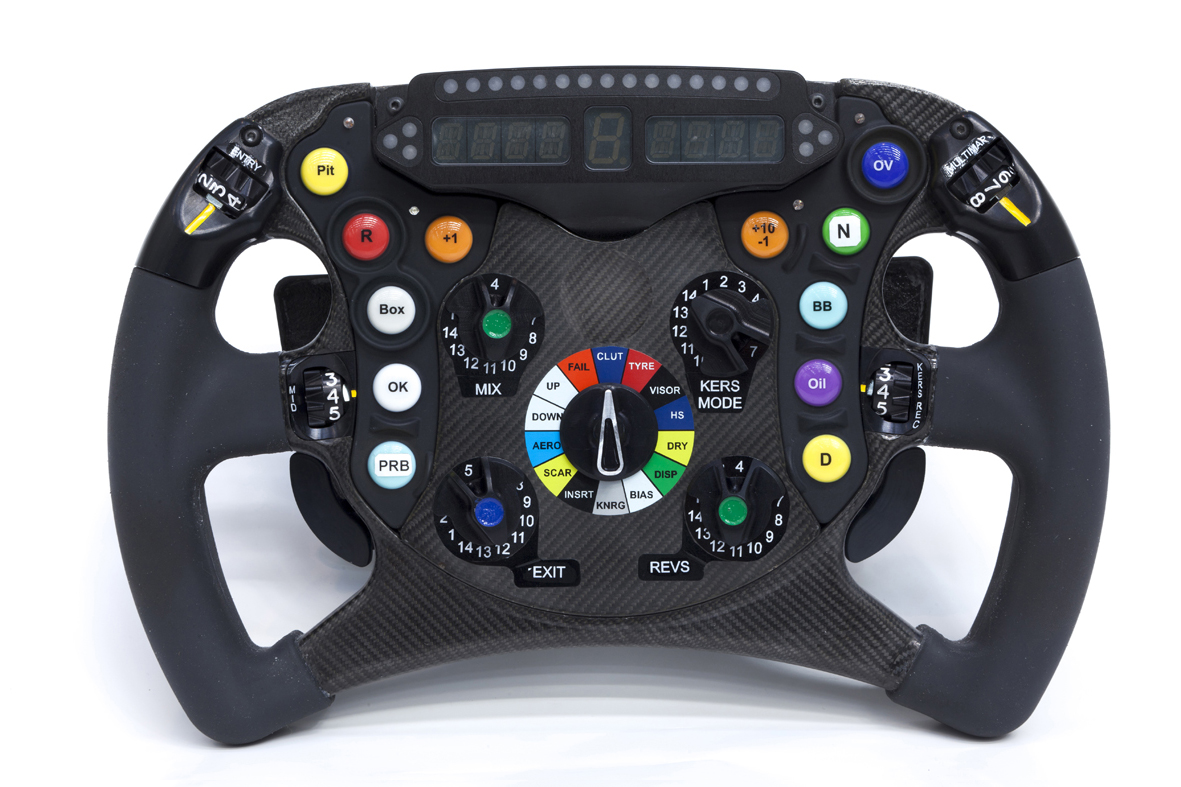The steering wheel
The move in Formula One from mechanical to electronic systems has been mirrored by the development of the steering wheel. No longer wheel-shaped or just for steering, the humble steering wheel now directly controls gearshift and clutch control, as well as a surprisingly wide range of other functions.
The ‘wheel’ itself tends to be carbon fibre, with the grips being either suede or the more common silicone mouldings. Attached to the steering column via a quick-release mechanism, it also serves as the connector to the car’s CANbus. From here the steering wheel’s design diverges from the norm to incorporate the paddles and buttons to control the various electronic and hydraulic systems on the car. Inside the wheel is a standard Interface unit, a circuit board that takes the inputs from the wheel’s controls and passes them back to the car’s CANbus. The board accepts 18 switch inputs and 11 variable inputs (0-5 V), which is a lot, but does limit the potential for even more controls on the steering wheel for the more technically minded driver.
Gearshift is controlled via paddles behind the wheel, usually a pair left and right, mounted to common yoke, such that pulling one paddle has the same effect as pushing the other. This movement is picked up by sensors at the paddles’ hinge point. Either Hall Effect or microswitches are used, doubled or even tripled up for redundancy. The paddle is sprung, and features bump stops to give the driver the positive feeling of the paddle requesting a gear.
Below these, two more paddles are used for clutch control, using rotary pots to detect the clutch paddle movement so that the clutch actuator can accurately reflect the movement.
Teams may use other paddles to serve multiple functions based on driver and team preference, such as operating the KERS or DRS (drag reduction system). For example, Mercedes AMG F1 had an overtake control called the ‘magic paddle’, which provided maximum engine power (mix and rpm) and DRS activation settings on just one control.
On the front of the steering wheel there’s a standard display panel and a plethora of buttons and rotaries. The display panel is another standard homologated part, and provides the usual range of shift lights, gear position indicator and alphanumeric displays. But it also has two sets of three LEDs linked to the circuit’s marshalling system, to display an LED coloured to match the flags around that sector of the lap (blue/yellow/red).
The buttons are grouped into two main types – pushbuttons that can be toggle or latches via the software, and the multi-position rotary controls. A few teams used toggle switches for the RS (Race Start) mode, which requires the driver to flick them back into normal mode after the race’s start.
Every team and most drivers have their preference for what the buttons and rotaries do on their steering wheel; this is a list of the more common controls.
Rotaries
Diff Entry – Alters the gearbox differential setting on entry to turns; this will alter the car’s handling
Diff Mid – Alters the gearbox differential setting at the midpoint of a turn; this will alter the car’s handling and traction
Diff Exit – Alters the gearbox differential setting at the exit point of a turn; this will alter the car’s handling and traction
KERS Mode – Alters the way KERS energy boost is delivered
KERS Recover – Alters the way KERS energy is harvested under braking
Revs – Alters the rev limit up to 18,000 rpm
Mix – Alters the engine power setting; more power uses more fuel
Multifunction – This controls less frequently used functions that don’t warrant a dedicated control. The driver will use this in coordination with the ‘+1’, ‘-1’ and ‘OK’ buttons listed below
Tyre – This tells the ECU what tyres are fitted: dry, intermediate or wets. It can also be used to inform the team of the state of tyre degradation
Pedal – Alters the relationship between pedal movement and the engine’s throttles.
Buttons
Acknowledge – Confirms that a verbal instruction was understood
Oil – Release additional oil into the engine
+1, -1 and OK – Used with the ‘Multifunction’ rotary to alter settings
Drink – Operates the driver drink system pump
DRS – Opens the rear-wing drag reduction system
Overtake - Sets engine mix and revs to maximum for overtaking
KERS – Discharges KERS boost
BPF – Bite point find for the clutch
Pitlane – Engages the pit lane speed limiter
Radio – Push to talk on the car-to-pits radio
Neutral – Selects neutral gear
Reverse – Selects reverse gear
 A typical Formula One steering wheel has one dash display, six paddles, nine rotary controls and more than 12 buttons
A typical Formula One steering wheel has one dash display, six paddles, nine rotary controls and more than 12 buttons
Written by Craig Scarborough